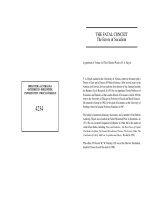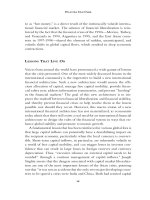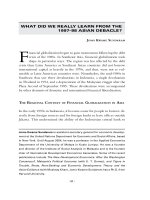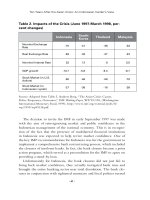Ten Years aFTer: Revisiting the AsiAn FinAnciAl cRisis phần 1 pot
Bạn đang xem bản rút gọn của tài liệu. Xem và tải ngay bản đầy đủ của tài liệu tại đây (411.19 KB, 14 trang )
TEN YEARS AFTER:
Revisiting the AsiAn FinAnciAl cRisis
edited by bhumikA muchhAlA
TEN YEARS AFTER: Revisiting the AsiAn FinAnciAl cRisis
Asia Program
Woodrow Wilson International Center for Scholars
One Woodrow Wilson Plaza
1300 Pennsylvania Avenue NW
Washington, DC 20004-3027
www.wilsoncenter.org/asia
TEN YEARS AFTER:
Revisiting the Asian Financial Crisis
TEN YEARS AFTER:
Revisiting the Asian Financial Crisis
Essays by:
Jomo Kwame Sundaram
J. Soedradjad Djiwandono
Meredith Jung-En Woo
David Burton
Robert H. Wade
Ilene Grabel
Mark Weisbrot
Worapot Manupipatpong
Edited by:
Bhumika Muchhala
October 2007
Available from :
Asia Program
Woodrow Wilson International Center for Scholars
One Woodrow Wilson Plaza
1300 Pennsylvania Avenue NW
Washington, DC 20004-3027
www.wilsoncenter.org
ISBN 1-933549-24-6
The Woodrow Wilson International Center for Scholars,
established by Congress in 1968 and headquartered in Washington, D.C.,
is a living national memorial to President Wilson. The Center’s mission
is to commemorate the ideals and concerns of Woodrow Wilson by pro-
viding a link between the worlds of ideas and policy, while fostering
research, study, discussion, and collaboration among a broad spectrum
of individuals concerned with policy and scholarship in national and
international affairs. Supported by public and private funds, the Center
is a nonpartisan institution engaged in the study of national and world
affairs. It establishes and maintains a neutral forum for free, open, and
informed dialogue. Conclusions or opinions expressed in Center publi-
cations and programs are those of the authors and speakers and do not
necessarily reflect the views of the Center staff, fellows, trustees, advi-
sory groups, or any individuals or organizations that provide financial
support to the Center.
The Center is the publisher of The Wilson Quarterly and home of
Woodrow Wilson Center Press, dialogue radio and television, and the
monthly news-letter “Centerpoint.” For more information about
the Center’s activities and publications, please visit us on the web at
www.wilsoncenter.org.
Lee H. Hamilton, President and Director
Board of Trustees
Joseph B. Gildenhorn, Chair
David A. Metzner, Vice Chair
Public members: James H. Billington, Librarian of Congress; John
W. Carlin, Archivist of the United States; Bruce Cole, Chair, National
Endowment for the Humanities; Michael O. Leavitt, Secretary, U.S.
Department of Health and Human Services; Tamala L. Longaberger, des-
ignated appointee within the Federal Government; Condoleezza Rice,
Secretary, U.S. Department of State; Lawrence M. Small, Secretary,
Smithsonian Institution; Margaret Spellings, Secretary, U.S. Department
of Education; Allen Weinstein, Archivist of the United States
Private Citizen Members: Robin Cook, Donald E. Garcia, Bruce S.
Gelb, Sander R. Gerber, Charles L. Glazer, Susan Hutchinson, Ignacio
E. Sanchez
| 1 |
Introduction 5
Bhumika Muchhala
What Did We Really Learn from the 21
1997-98 Asian Debacle?
Jomo Kwame Sundaram
Ten Years After the Asian Crisis: 39
An Indonesian Insider’s View
J. Soedradjad Djiwandono
A Century after the Unparalleled Invasion: 53
East Asia After the Crisis
Meredith Jung-En Woo
Asia and the International Monetary Fund: 63
Ten Years After the Asian Crisis
David Burton
The Aftermath of the Asian Financial Crisis: 73
From “Liberalize the Market” to
“Standardize the Market” and Create a
“Level Playing Field”
Robert H. Wade
One Step Forward, Two Steps Back: 95
Policy (In)Coherence and Financial Crises
Ilene Grabel
contents
| 2 |
Ten Years After: The Lasting Impact 105
of the Asian Financial Crisis
Mark Weisbrot
Regional Initiatives for Financial 119
Stability in ASEAN and East Asia
Worapot Manupipatpong
| 3 |
ABMI Asian Bond Markets Initiative
ADB Asian Development Bank
APEC Asia Pacific Economic Cooperation
ASA ASEAN swap arrangement
ASEAN Association of Southeast Asian Nations
ASEAN+3 Association of Southeast Asian Nations plus China,
Japan, and South Korea
ASP ASEAN Surveillance Process
ASR ASEAN Surveillance Reports
BBPN Indonesian Bank Restructuring Agency
BI Bank Indonesia
BIS Bank for International Settlements
BSA Bilateral swap arrangement
CBS Currency board system
CCL Contingent Credit Lines
CMI Chiang Mai Initiative
EMEAP Executives’ Meeting of East Asia-Pacific Central
Banks
ENSO El Nino Southern Oscillation
ERPD Economic Review and Policy Dialogue
FSAP Financial Sector Assessment Program
FSF Financial Stability Forum
FTA Free Trade Agreement
G7 Group of Seven
glossary
| 4 |
G8 Group of Eight
GDP Gross domestic product
HIPC Heavily Indebted Poor Countries
IEO Independent Evaluation Office of the International
Monetary Fund
IIF Institute for International Finance
IMF International Monetary Fund
IRB Internal ratings-based
LDCs Lesser-developed countries
LTCM Long-Term Capital Management
NIFA New international financial architecture
OECD Organization for Economic Cooperation and
Development
OPEC Organization of the Petroleum Exporting Countries
ROSCs Reports on the Observance of Standards and Codes
SDDS Special Data Dissemination Standards
SDRM Sovereign Debt Restructuring Mechanism
SME Small and medium enterprise
TOU Terms of Understanding
VIEWS Vulnerability Indicators and Early Warning Systems
WTO World Trade Organization
| 5 |
Bh u m i k a mu c h h a l a
T
he Asian financial crisis of 1997-98 is now seen as one of the
most significant economic events in recent world history. The
crisis began in early July 1997, when the Thai baht was floated,
and spread into a virulent contagion—leaping from Thailand to South
Korea, Indonesia, the Philippines, and Malaysia. It led to severe currency
depreciations and an economic recession that threatened to erase decades
of economic progress for the affected East and Southeast Asian nations.
The sequence of events triggered a self-reinforcing spiral of panic, which
many analysts argue was premised on a confluence of the inherent volatil-
ity of financial globalization and the weak domestic financial systems in
East Asia. Financial liberalization in the region led to surges in capital flows
to domestic banks and firms, which expanded bank lending, ultimately
resulting in a rapid accumulation of foreign debt that exceeded the value
of foreign exchange reserves. As international speculation on dwindling
foreign reserves mounted, the regional currencies came under attack.
During the summer of 1997, Thailand sharply reduced its liquid for-
eign exchange reserves in a desperate attempt to defend its currency.
When the Thai baht was cut loose from its dollar peg, regional curren-
cies plunged in value, causing foreign debts to skyrocket and igniting
a full-blown crisis.
1
By mid-January 1998, the currencies of Indonesia,
Thailand, South Korea, the Philippines, and Malaysia had lost half of
their pre-crisis values in terms of the U.S. dollar. Thailand’s baht lost 52
percent of its value against the dollar, while the Indonesian rupiah lost
84 percent. During the last stages of the Asian crisis, the regional “finan-
cial tsunami” generated a global one as Russia experienced a financial
crisis in 1998, Brazil in 1999, and Argentina and Turkey in 2001.
IntroductIon
Bhumika Muchhala was program associate in the Asia Program of the Woodrow
Wilson International Center for Scholars until August 2007. She is now in the
Policy Program of the Bank Information Center.
Bhumika Muchhala
| 6 |
The various participants in the Asian crisis ranged from Wall Street
to Jakarta. Asian and Western governments, the private sector, and the
International Monetary Fund (IMF, or the Fund), established to provide
temporary financial assistance to help countries ease balance of payments
adjustments, all played crucial roles in the sequence of the crisis. Perhaps
the most controversial role was that of the IMF. Its critics argue that the
stringent monetary policies and financial sector reforms attached to the
Fund’s loan programs exacerbated the crisis, while its supporters main-
tain that those very policies helped to dampen the effects of the cri-
sis. Governments, banks, and firms in the crisis-affected countries were
charged with “fundamental weaknesses,” in that a lack of transparency
and regulatory oversight in domestic financial systems and institutions
was at the roots of the crisis. The international market was seen to have
acted in panic, as a “herding” effect prompted a massive capital outflow
from the East Asian countries.
The resulting economic recession shocked the world with its stagger-
ing economic and social costs. Over a million people in Thailand and
approximately 21 million in Indonesia found themselves impoverished
in just a few weeks, as personal savings and assets were devalued to a
fraction of their pre-crisis worth. As firms went bankrupt and layoffs
ensued, millions lost their jobs. Soaring inflation raised the cost of basic
necessities. Strapped fiscal budgets imposed a financial squeeze on so-
cial programs, and the absence of adequate social safety nets led to grim
economic displacement. Poverty and income inequality across the re-
gion intensified, as a substantial portion of the gains in living standards
that had been accumulated through several decades of sustained growth
evaporated in one year.
The severity of the Asian financial crisis came as a genuine surprise
to many in the international community because the affected countries
were the very economies that had achieved the “East Asian miracle.”
The East Asian miracle that saw the transformation of East Asian econo-
mies from poor, largely rural less-developed countries to middle-income
emerging markets has been one of the most remarkable success stories in
economic history. Scholars assert that the East Asian miracle was real, as
not only had GDP significantly increased, but poverty had decreased,
and literacy rates as well as health indicators had improved.
2
Overall
poverty rates for East Asia fell from roughly 60 percent in 1975 to 20
Introduction
| 7 |
percent in 1997. So, what happened? How did the very economies that
were being praised for their dramatic success turn into the same ones
being reprimanded for their collapse?
De B a t i n g t h e Di a g n o s i s
The impact of the Asian financial crisis raised deep doubts about the
reigning ideology of financial globalization and the design of the inter-
national financial architecture. The volume of literature and analyses
on the root causes of the Asian crisis, and the lessons that need to be
learned, is extensive. Scholars and analysts debate a wide diversity of
arguments and counter-arguments, and thus, while popular perspectives
abound across different communities, there is no one single consensus
on the causes of the crisis.
One group of experts maintains that the crisis resulted from the “fun-
damental weaknesses in the domestic financial institutions” of the af-
fected countries.
3
This group of analysts argues that the liberalization of
domestic financial markets was not accompanied by necessary levels of
transparency and regulation. Corporate financial structures in the region,
too, it is argued, were riddled with governance problems such as endemic
corruption, the concentration of ownership, and excessive levels of gov-
ernment involvement. The counter-argument emphasizes that the eco-
nomic successes of the East Asian economies belies the notion that they
were “dysfunctional economies.” This group of analysts states that the
lack of transparency and the weakness of financial systems do not neces-
sarily lead to financial crisis—otherwise, what can explain the relative
insulation from the Asian crisis for countries such as China and India?
In the ten years since the Asian crisis, many scholarly as well as popu-
lar evaluations of the crisis have contended that international financial
liberalization, characterized by the free and rapid mobility of short-term
capital, played the central role in instigating the crisis. In the decade
that preceded the onset of the crisis in mid-1997, East Asian economies
had moved toward financial liberalization, which can leave develop-
ing countries vulnerable to financial speculation, sudden changes in the
exchange rate, and surges in capital inflows, which simultaneously in-
creases the risk of capital outflows. This phenomenon, often referred









